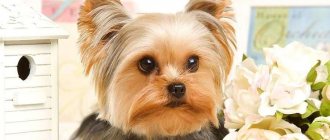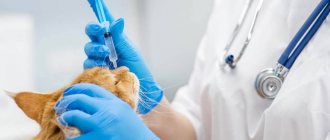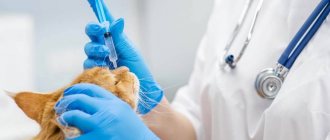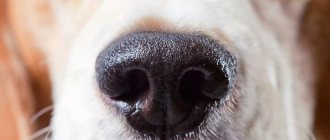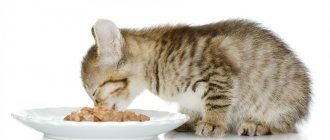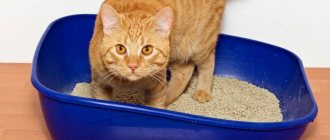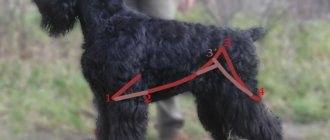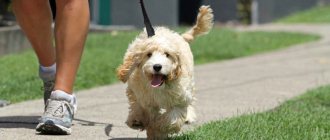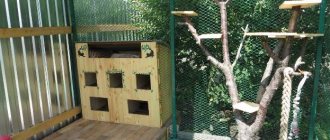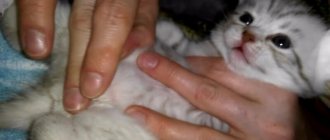A cat's nose is an important organ necessary for normal functioning.
The animal receives a large amount of information about the environment through the sense of smell, so it suffers when problems arise with breathing. The causes of this condition may be a runny nose or accumulation of dirt on the mucous membranes.
Veterinarians recommend rinsing your cat's nose. The procedure helps relieve your pet of such unpleasant symptoms as difficulty breathing, sneezing, and snot.
The manipulation should be done correctly, using special tools and materials.
Washing has its own characteristics. Depending on the cause of nasal congestion in a cat, various means are used with which the procedure can be carried out at home.
Cleaning should be thorough and gentle so as not to harm the pet.
Can cats have their nose cleaned?
Sometimes an animal suffers from nasal congestion and cannot do anything about it.
It is recommended for cats to clean their nose in the following cases:
- with a runny nose;
- to remove contaminants.
A runny nose in a cat can be caused by various diseases. It is accompanied by nasal congestion, sneezing, and sometimes other symptoms.
To alleviate the animal's condition, it is important to clear its nose of snot.
The accumulation of dirt in the nasal passages is observed in every animal. This condition is manifested by wheezing, labored and slow breathing.
A cat's nose is an indicator of health
A healthy cat's nose should be fairly cool to the touch, smooth and maybe even a little slippery. But after sleep, active play or stress, the cat’s nose may become warmer - this is normal.
Changes in color may be a sign of poor circulation. For example, a bluish color may be a sign of heart disease or lack of oxygen. Reddish, inflamed nasal mucous membranes may be a symptom of rhinitis, infection, or mechanical irritation.
When a cat's nose is red, it could be a sign of high blood pressure, fever, or allergies. A yellowish color of the nose is a sign of liver or kidney dysfunction.
Note! A pale and very cold cat's nose may indicate systemic diseases, a cold, shock, a sharp decrease in body temperature or poisoning.
Causes and symptoms
Sneezing and discharge in an animal can be caused by infectious and non-infectious causes. Depending on this, you need to build treatment. Cats have a very high immunity, and colds - so frequent and even commonplace for humans - are rather an exception to the rule for an animal. Colds and runny noses are more common in homeless cats during periods of cold and rain. Colds occur for several reasons:
- The room is too damp, drafty.
- High humidity.
- Lack of vitamins, poor nutrition.
- Sudden temperature changes.
- The animal is hypothermic or wet (this can happen if the cat, for example, is not dried well after bathing).
Symptoms that will indicate a cold:
- Dry or, conversely, hot nose.
- Hair loss or dullness.
- Great lethargy.
- The cat sleeps for a long time or gets very scared of something that didn’t bother her before.
- Weakness (the animal stands well on its feet, but is apathetic), increased fatigue.
- Decreased appetite.
With a cold, breathing becomes difficult, the snot is clear and not viscous. The cat sneezes and coughs heavily, and the eyes may water. If discharge sticks to the muzzle or crusts appear, this means that the disease is becoming serious and may progress to the pathological stage.
Allergy
If the animal sneezes, tries to constantly rub its eyes and nose, and discharge of a transparent texture appears from the eyes, most likely, we are talking about an allergic rhinitis. The snot in this case is liquid, transparent in color (odorless), and may be accompanied by swelling and dermatitis. Breathing is impaired and itching is likely.
REFERENCE
Cats can develop allergies to a certain product. After consultation with a veterinarian and tests, he will have to be ruled out. There may be allergies to medications, pollen, house plants, and even household items. Most often, the animal reacts to the irritant after several hours, but symptoms can appear several days after encountering the allergen.
Fungi and bacteria
Human ARVI, most often, is not transmitted to cats, but if the disease is caused by certain fungi and bacteria, then both the owner and the pet can become infected with a runny nose.
A bacterial infection is indicated by:
- unpleasant smell of discharge and its yellow-green color;
- accumulation of pus in the corners of the eyes or over the entire surface;
- snot from the nose and tears from the eyes;
- constant sneezing and coughing;
- the animal constantly swallows, this is due to the fact that mucus accumulates in the nasopharynx;
- body temperature rises;
- loss of appetite;
- dehydration;
- prolapse of the third eyelid.
Fungal infections overwhelm animals with weak immunity and often the runny nose becomes chronic. An indicator of a bacterial infection is a crust in the nose, which makes breathing very difficult and snot comes out of the nose.
Foreign bodies
Coughing and sneezing may be caused by a cat swallowing a foreign object in its intestines or esophagus. If this happens, the symptoms will be as follows:
- Profuse salivation.
- If a foreign body is in the throat, then coughing and wheezing appear, the tongue turns blue, and the cat may lose consciousness.
- Constant swallowing.
- Vomiting and belching.
- Complete lack of appetite.
- Bloating.
- Lethargy, apathy, drowsiness.
- Diarrhea, constipation.
- Symptoms of general intoxication.
A runny nose can result from birth defects and injuries. For example, a “cleft palate,” that is, disturbances in the structure of the upper jaw and nasal bones, will cause the cat difficulty breathing and wheezing. Injuries to the jaw or head can result in a cleft palate. The bones can become displaced, and all this together will give the animal a chronic runny nose.
With such pathologies, the discharge does not have an unpleasant odor and most often does not affect the general condition of the cat (if the injury is cured and is not life-threatening). To clarify the causes of chronic runny nose, you should contact your veterinarian. He will identify the pathology and tell you whether it is possible to treat it or eliminate the symptoms.
A runny nose can be an indicator of inflammation that occurs in the nasopharynx or ears. And it will not go away until the initial inflammation is removed.
Why do cats get ear infections?
- Infections.
- Hypothermia.
- Other specific diseases.
Why gums and teeth can become inflamed:
- Malocclusion.
- Lack of vitamins.
- Caries.
- Tartar.
- Injury.
- Irradiation.
- Virus.
- Chemical poisoning.
With inflammation, the following clinical picture is observed:
- breathing quickens;
- discharge from the eyes becomes watery;
- the animal periodically breathes through its mouth;
- sneezing occurs infrequently;
- purulent snot, gray-green, whitish, yellow, sometimes even with traces of blood;
- loss of appetite.
Other problems that cause coughing, sneezing and sniffles include:
- Parasites, for example, worms.
- Tumor of the nasopharynx.
- Neoplasms.
- Chronic diseases.
- Infections.
- Stress.
Treatment of rhinitis
A runny nose and inflammation of the mucous membranes should be treated promptly ; there is no need to wait for complications for the pet to become deaf or for the inflammation to spread to other respiratory organs.
- If rhinitis occurs due to an infection, bacterial or viral, the veterinarian prescribes antibiotics and antibacterial drugs, taking into account the animal’s age and breed. It is important to strictly adhere to the instructions and carry out the course of treatment to the end, even if there is no discharge and the nose can breathe freely.
- The course of treatment for rhinitis may include antipyretic, anti-inflammatory, and sedative drugs.
- Sometimes the veterinarian recommends rinsing the animal’s nose to ease its breathing and general condition.
- Inhalations with essential oils are effective for rhinitis; you just need to strictly follow the dosage of oil drops. The nose is also warmed up with warm sand or salt wrapped in a clean cloth.
- If your pet has dry skin around its nose, you can constantly moisturize it with baby cream or Vaseline.
If you need to clear your nose, you should act very carefully and carefully , following the advice of experts. Wounds can not only cause pain, but also become a source of infection . You can clean the crusts with a damp cotton swab.
Basic cleaning rules
It is necessary to clean your pet's nose when it is dirty and from snot.
It's important to do it right.
In order not to scare the animal and quickly carry out the procedure, you should adhere to the following rules:
- the first rinsing is performed under the supervision of a veterinarian;
- It is not allowed to use medications that are used to wash a person’s nasal passages;
- nasal cleaners must be purchased at a veterinary pharmacy;
- You cannot use folk remedies based on salt, iodine or soda, since these components can cause swelling of the nasal mucosa and allergic reactions;
- Each nostril should be rinsed.
Before the procedure, the pet should be immobilized and calmed. To do this, wrap it in a towel or other soft but durable material. After completing the actions, the animal needs to be encouraged - petted and given its favorite dish.
Cat has a runny nose
Often cat owners are faced with a pet disease such as rhinitis . The cat suffers from a runny nose and a stuffy nose, because it loses its unique ability to accurately and quickly navigate the environment and recognize danger. What manifestations of rhinitis can be noticed?
- The animal not only has difficulty breathing through its nose, it cannot run or play calmly. It also becomes more lethargic, detached, loses appetite, and looks depressed.
- You can see the cat scratching its nose with its paw, fiddling with it, trying to clear it of congestion.
- Sometimes the temperature rises, even up to 39 degrees. If you touch your pet's nose, you can notice how hot it has become.
- Another sign of rhinitis can be conjunctivitis. It is necessary to wash the animal’s eyes so as not to aggravate the inflammation.
Nasal rinses
The cat can be washed with the following preparations:
- Dioxidine. It is recommended to dilute this medicine with Naphthyzin nasal drops for children in a 1:1 ratio.
- Saline solution. Most often offered in ampoules.
- Special solutions for washing. Gamavit is used to cleanse the upper respiratory tract. Mastiet forte is also considered an effective remedy.
- Furacilin. To prepare the product, you need to dissolve ¼ of the tablet in a glass of warm water.
- Chlorhexidine. It is recommended to dilute the drug with water in a 1:1 ratio.
These products should be purchased from a veterinary pharmacy.
Alternative rinses include:
- aloe juice;
- beet juice.
You can use decoctions of medicinal plants. It is best to use oak bark, chamomile, and string.
It is important to remember that the juices of these plants must be diluted with warm boiled water . These products should be used freshly squeezed and not concentrated.
Water and aloe or beet juice are diluted in a ratio of 1:4.
What is an aspirator?
A nasal aspirator (nasal aspirator) is a device for removing excess mucus from the nose, which allows you to restore the patency of the nasal passages and thereby restore breathing through the nose.
Aspirators for children come in various designs, differ in manufacturer and price category, but they have the same operating principle - suctioning mucus from the nose.
Below we will consider the different types of these devices and the principles of their operation.
Anandin
One of the most common drugs for the treatment of rhinitis. In addition, the medicine can be used in the treatment of diseases of the eyes and ears.
The composition includes glucaminopropylcarbacridone, which has a pronounced anti-inflammatory effect. In addition, the active substance enhances the local and general immune status of the body. The following indications for use are distinguished:
- Rhinitis of bacterial and viral origin.
- The product can be used as an auxiliary medicine in the treatment of fungal inflammation of the nasal cavity (Anandin alone cannot cope with fungi).
- In addition, the medicine helps to cope with rhinitis of allergic etiology.
There are usually no difficulties when using the drug:
- For mild rhinitis, drop two drops into each nostril twice a day. The period of use is approximately a week.
- In the case of rhinitis with moderate and severe intensity of the inflammatory process, the dose can be increased to three or four drops in each nostril, the frequency of use can be increased to three times a day. The duration of use in this case should not exceed two weeks.
How to make breathing easier?
In this case, you will need special nasal drops that constrict the blood vessels. They should be dripped into each nostril of the nose, treatment will take about a week.
ATTENTION! Before you put drops in your pet's nose, you should first clean it of crusts. You cannot use cosmetics for this purpose that the cat can inhale.
For instillation, only drops for cats are used, no drugs for humans . Medicines for animals have such important additional properties as immunostimulating effects.
When treating kittens, medications are prescribed taking into account their young age. Sometimes even children's drops, such as Pinosol and Protargol, are suitable. You should only drip the number of times indicated in the instructions; an excess of the medicine will not bring any benefit , and there may even be complications.
You shouldn't rely on your intuition when treating your cat's nasal congestion or other health problems. There are videos on special websites that will help you treat your cat competently and safely. In any situation, pet owners should follow the recommendations of veterinarians and breeders who have professionally studied all the features of caring for cats .
Cleaning your nose when you have a runny nose
Cleaning your cat's nasal passages will help relieve your pet of a runny nose. It is carried out according to the following algorithm src=»https://nashakisa.ru/wp-content/uploads/2019/01/foto-9-1-360×270.jpg» class=»aligncenter» width=»360″ height= "270"[/img]
- The rinsing solution is carefully drawn into the syringe. The dosage should not exceed 0.5 ml. The needle is removed from the syringe. You can also use a pipette.
- The animal is wrapped in thick cloth or a towel to avoid scratches. To calm your pet, it is also recommended to attach a clothespin to the withers.
- The end of the syringe is carefully inserted into the nasal passage.
- The liquid is introduced slowly. Gently press the syringe plunger.
- You need to rinse each nostril with the solution.
- After this, wipe off the discharge with a cotton pad. It can be replaced with a small cotton wool turunda.
For a runny nose, use saline or other means. An effective procedure is rinsing with Chlorhexidine or Furacilin.
Usually a cat’s rhinitis goes away after 1-2 manipulations.
If other symptoms of the disease develop or the washing procedure is ineffective, it is necessary to show the cat to a veterinarian.
How to prepare for ear debridement
- The animal may jerk its head during the procedure, which carries the risk of damage to the ear canal.
- During the cleaning process, the cotton part may remain in the ear, which is dangerous for the pet.
- There is a risk of scratching the inside of the ear with a hard object, which can cause infection.
To eliminate the smell, dilute acetic acid (essence) with water in a ratio of 1:2, wipe the stained area and rinse well with clean water. You can pre-treat the stained area with a solution of laundry soap. The product smells specific, but still more pleasant than the smell of cat urine.
Creating a comfort zone
If your cat has an unfortunate runny nose, you should not quarantine the entire territory of the apartment. At a minimum, it is necessary to provide your furry pet with a soft and dry bed, as well as peace and warmth.
You can speed up your cat's recovery by taking some simple steps:
- Protect the sick animal from communicating with its relatives so that other cats do not get sick either;
- Place a humidifier in the room where your cat is most present. This will help create increased humidity and make breathing much easier for the animal;
- Make sure that there is always a bowl of clean water next to the cat. This will help prevent dehydration, which is extremely undesirable for a sick pet;
- Clean your eyes and nose periodically with moistened cotton swabs. This will make it possible to prevent the formation of crusts on the eyes and nose. And also watch for changes in the color of the discharge; if it turns green, then you should show the animal to a doctor;
- To prevent the formation of a crust and avoid increased dryness in the nose, it is necessary to lubricate the area around it with baby oil or Vaseline;
- You can try children's drops for runny nose, which need to be dripped once a day into one nostril. The next day, also 1 drop, but in the other nostril. Continue treatment for 5-7 days.
Preventing sneezing in cats
In order to prevent your tailed pet from getting sick, you should follow simple maintenance rules: eliminate drafts in the house, provide your pet with a warm place to sleep, change the litter in the tray or change the diet if an allergy is detected. It is also necessary to carry out timely cleaning of the house and not to spray chemicals near the pet. It is advisable to install a humidifier for it. If your cat is sick, there is no need to disturb him again; it is better to give him more water and follow the treatment prescribed by the doctor.
Under no circumstances should you self-medicate, this is fraught with complications that can lead to serious consequences!
You should also visit your veterinarian annually for examinations and vaccinations. Do not allow your pet to come into contact with stray animals. Once every three months, treatment for parasites should be carried out. And of course, the most important thing is to surround your pet with your love and care!
Cleaning from dirt
Veterinarians say that the animal's nasal passages clear themselves, so intervention is usually not required. But if your cat is acting restless or exhibiting other symptoms, she should have her nose cleaned.
The washing steps should be as follows:
- Draw boiled water at room temperature into a syringe or pipette.
- Immobilize the pet using a clothespin at the withers or wrapping it in thick material.
- With one hand, support the animal by the head, and with the other, pour in the solution in a thin stream. Liquids are drawn into the syringe no more than 0.5 ml.
- After rinsing one nostril, the manipulation is repeated with the other.
- Remove dirt with a cotton swab.
It is important to calm the animal . To do this, it is recommended to stroke it. Upon completion of the procedure, the pet must be rewarded by giving it a favorite treat.
Stages of the procedure
- Before use, the lotion must be warmed in your hand so that cold drops do not cause discomfort to the animal.
- Then the bottle must be shaken vigorously for several seconds.
- Open the cap and place 2-5 drops of the product on the inside of the ear.
After cleaning, treat your pet to his favorite treat. The cat should associate the process with pleasant moments so that it is easy to carry out in the future.
Folk remedies for odor
This method has another advantage - cats cannot tolerate the strong, stinky smell. In this way, you can kill two birds with one stone - remove the smell and discourage the cat from doing its business in the wrong place. According to many, vinegar is one of the most effective home remedies for odor removal.
Expert opinion
Ekaterina Korneva, expert in the field of care, cleanliness and beauty
I will help you understand all the intricacies.
To eliminate the smell, dilute the acetic acid essence with water in a ratio of 1 2, wipe the stained area and rinse well with clean water. After the mustachioed friend is immobilized and does not pose a threat to the owner, you can proceed to the main stages. Algorithm of actions For any questions, please contact me, I will be happy to answer!
We focus on food
- One of the most common treatments is appetite stimulation. The essence of the method is that an animal with a clogged nose cannot smell food, so its craving for food sharply decreases and, over time, a loss of strength occurs.
- You can help restore the vital energy that is so necessary to fight the insidious infection by offering your cat something that smells very appetizing. It could be delicious fish or meat, or some special dish that your pet likes.
- If your pet is accustomed to cat food, then offer him a canned version, which, unlike dry food, has a more pronounced aroma. If the animal does not want to eat, then you can lubricate the cat’s nose with sour cream or pate. The focus on cleanliness should work here; the cat will definitely lick its nose and, perhaps, taste the deliciousness.
How often can a cat's nose be washed?
There is no exact schedule for nasal rinsing for cats - if they are healthy cats of a non-brachycephalic breed, they will cope with hygiene on their own, without the help of their owners. If you see symptoms that indicate that your cat has difficulty breathing and she cannot cope with the problem on her own (or does not want to do so), rinse your pet’s nose.
This can really be done at home if you follow all the rules and recommendations. But keep in mind that if serious symptoms appear, rinsing and instilling may not be enough. In this case, you should immediately contact a specialist, since your pet may have a serious illness that needs immediate treatment.
Features of the procedure in newborn kittens
A newborn kitten will also occasionally need to clean out postpartum discharge from her nose. Sometimes the procedure needs to be done in order to free the baby’s nostrils from contamination.
The kitten also has a runny nose, which prevents it from breathing. Therefore, the nasal passages should be cleared of snot.
Since kittens' nasal passages are very small, they should be cleaned carefully.
The procedure is characterized by its own characteristics:
- washing must be done with a pipette;
- do not use a syringe;
- the kitten is immobilized with a towel;
- approximately 0.2-0.3 ml of solution is injected;
- the liquid should not be too cold or hot;
- the solution is poured into each nasal passage.
You can clean your kitten's nose with saline solution, Chlorhexidine or boiled water.
Preventive measures
What to do to avoid a runny nose in a cat, which can cause its condition to worsen?
- It is necessary to avoid situations during which the cat may become hypothermic or catch a cold.
- Vaccination effectively helps prevent infectious and fungal diseases.
- It is important to increase the animal’s immunity through proper feeding.
- If your pet suffers from allergic reactions, sources of allergy should be excluded from the home environment. The source can even be food of a certain brand and composition.
Rating of the best aspirators for newborns
Parents often ask the following questions: “Which is the best and safest nasal aspirator for newborns? How to use a nasal aspirator? How to choose an aspirator for newborns? Below we present to your attention some of the best representatives of various types of these devices.
It is important to choose the right aspirator for your child.
Syringes
Among this type it is worth highlighting:
- Chicco.
- Farlin BF-138. Made from hypoallergenic material. The kit comes with different sizes of nozzles. Thanks to the device, when you press the bulb again, the mucus does not get back into the nose.
- Alpina Plast.
Mechanical
On pharmacy shelves you can find aspirators such as:
- Canpol.
- Aqualor Baby.
- Aqua Maris.
- Pigeon with drain tube.
- Marimer.
- Otrivin Baby.
Electronic
The most popular among them are:
- B.Well WC-150.
- Coclean New.
- Cleanoz.
Vacuum
Among vacuum devices, special attention is paid to the Baby-Vac aspirator. As mentioned earlier, the disadvantage is the noise during use.
"Dolphin"
This remedy for the common cold includes portioned powders for preparing a solution and a special container for rinsing the nasal cavity.
The composition of the classic “Dolphin” includes a mineral complex and plant components: licorice and rose hip extracts. When the powder is diluted with water, the patient receives an isotonic solution, which, due to additional components, has anti-inflammatory, antiseptic and immunomodulatory effects.
For people prone to allergic reactions, a special “Dolphin for allergies” was created, which contains only a complex of minerals, without the addition of herbal ingredients.
Rehabilitation period after surgery
Stopping nosebleeds is a kind of surgical intervention, which requires daily observation by an ENT doctor and postoperative rehabilitation. Patients who have had nasal tampons or hemostatic sponges installed receive hemostatic therapy after stopping the bleeding. If necessary, they are transfused with components of lost blood and undergo therapy aimed at lowering blood pressure. On average, a patient stays with a tampon in his nose for 3-7 days. After which the tampons are carefully removed, and the patient is under daily medical supervision for several days. During the rehabilitation period, it is important to continue taking medications that strengthen blood vessels, accelerate healing and moisturize the nasal mucosa.
First aid for nosebleeds
- Call an ambulance or see an ENT doctor at the nearest clinic.
- Place the patient in a sitting position. Throwing your head back or lying down is undesirable. It is better to take a vertical position, placing a tray under your chin to determine the volume of lost blood.
- If the patient suffers from hypertension, measure blood pressure and take blood pressure-lowering medications prescribed by the doctor.
- Apply cold to the nose area and apply a cold towel to the collar area.
- Moisten cotton wool with 3% hydrogen peroxide and place it in the vestibule of the nose.
- Press the wing of the nose against the septum for 10-15 minutes.
Types of nasal aspirators for newborns and young children
There are the following types of nasal aspirators:
- Syringes . They are a fairly simple device. They consist of two main parts: a soft rubber bulb and a silicone nose tip. Some of them have a stopper that will prevent the tip from going deeper. The simplicity of the design makes it easy to disassemble, wash and process its components. The operating principle is simple. Pressing the bulb causes a vacuum to appear when inserted into the nose, which facilitates suction of the contents.
One of the simplest methods of aspiration is a syringe.
- Mechanical . Mechanical devices consist of the following parts: a tube and a snot reservoir. Replaceable filters are also available. The principle of operation of this device is to insert the tip into the nostril and sip air towards yourself. The filter prevents the mucous contents of a child's nose from entering the adult's mouth.
- Electrical . These devices are the most effective. The downside is their high cost compared to other types of aspirators. Using this device is even easier. To remove snot, you need to insert a soft tip into the nasal passage and press the button on the device
- Vacuum . They are also quite an effective device. What's unusual is that it needs to be connected to a vacuum cleaner to use it. This device is not popular among pediatricians. This can be explained by the fact that when used, the vacuum cleaner is large and noisy, which frightens children.
The most popular among all types are syringes and mechanical nasal aspirators. But it is worth noting that electronic ones are in no way inferior to mechanical ones. Preference is given to mechanical ones solely for financial reasons.
Causes of nosebleeds
To understand the causes of bleeding, you should know the anatomical structure of the nose and its functions. The nose and nasal cavity belong to the upper parts of the respiratory system. When we inhale, the air in the nose is cleaned, warmed and moistened. The vasomotor function is performed by the extensive vascular network located in it. When cold and dry air enters the nose, the vessels dilate and become full of blood, due to which the mucous membrane thickens and allows less air to pass through in order to warm and moisturize it. The opposite processes occur when warm, humidified air enters.
The vessels in the nasal cavity originate from the system of the external and internal carotid arteries. They are responsible for the blood supply to the anterior sections of the nasal septum. The weak point of the nasal vascular system is the anastomosis - the junction of capillaries from the external and internal carotid artery systems. There are two such places in the nasal cavity, and both of them are located in the area of the nasal septum. In the anterior sections it is the vascular bundle of Kisselbach (LocusKisselbahi), in the posterior sections it is the Woodruff bundle (plexusWoodruff). The vessels in the anastomotic area have a thin wall, covered on top with a thin mucous membrane of the nasal cavity. Therefore, minor injuries, increased pressure, dry cold air cause damage to these vessels.
A common cause of nosebleeds is injury. Such bleeding is called post-traumatic. But, in addition to traumatic ones, there are also iatrogenic causes. They represent nosebleeds after operations, manipulations in the nasal cavity (puncture, catheterization), installation of nasogastric or nasotracheal tubes during anesthesia or gastric lavage, endoscopic examination of the nasal cavity.
A deviated nasal septum, adenoid vegetations, aneurysms of the vessels of the nasal cavity, an oncological process or neoplasms in the nose are all risk factors.
Diseases of internal organs and diseases of the cardiovascular system can also cause nosebleeds. Most often it occurs in patients with hypertension with increased blood pressure. In case of incorrectly selected therapy and the patient does not comply with the doctor’s recommendations to stabilize the pressure, surges occur that lead to damage to blood vessels.
Cases of nosebleeds are common in patients taking anticoagulants (drugs that reduce blood clotting).
Ruptures of mucosal capillaries can also occur when:
- colds;
- taking narcotic drugs;
- frequent use of vasoconstrictor drugs;
- being in a dry and cold climate;
- overheating of the body (sunstroke);
- with vitamin deficiencies (vitamin C deficiency);
- with alcohol abuse;
- quickly diving into water or climbing a mountain.
"Marimer"
The drug is an isotonic solution prepared from purified sea water. "Marimer" contains microelements that have a beneficial effect on the functioning of the ciliated epithelium of the nasal cavity. As a result, the resistance of the mucous membrane to infectious agents – viruses and bacteria – increases.
The drug is approved for use by pregnant women and children over 1 year of age. Can be used to relieve allergic rhinitis.
What are these funds?
The basis of the vast majority of nasal rinsing solutions is sea water. This component is able to effectively remove mucus from the nose along with the viruses and bacteria found in it, and also cope with swelling due to the salt content in the composition.
Sea salt naturally fights inflammation, soothes irritated mucous membranes, and helps eliminate wounds and microcracks that appear due to frequent nose blowing. In addition, sea water contains useful microelements, such as iodine, which has a bactericidal effect.
Often, rinsing solutions are physiological, that is, the salt concentration in them is 0.9%, which corresponds to the internal environment of the body. Therefore, preparations based on saline solution are absolutely safe and approved for use even for newborns.
